
Your Back-to-School Strategy Is Backwards: Skip One-Off Seasonal Promotion for Gen Z Loyalty

Here’s a math lesson for brands to brush up on this summer. College students represent the ultimate '$2-for-$1' marketing opportunity.
The 18-to-22-year-old period is an intensely formative time for young adults. This is the first time a person becomes a consumer in their own right. They’re responsible for budgeting. And when it’s your money, the consideration for a purchase takes on a deeper meaning. This point in a young person’s life is, therefore, the best time for brands to build relationships that could last decades.
The ROI equation is simple: every dollar spent reaching college students during this critical life transition can yield exponentially higher returns than those allowed by the traditionally narrow focus on lower-funnel marketing. Just as college is about opening students up to new ideas, brands also need to move beyond their own short-term thinking.
Earning While They're Learning
Education isn’t over when you hurl your cap into the air after being handed your diploma. The process of learning is ongoing. The same is true for the personal and professional networks students gather and take with them as they progress. Trust in them is accumulated and bolstered through positive experience.
Brands can learn from this: Just like those people in a young person’s growing networks, brands have to earn, rather than buy their way into consumer networks. For brands and college-age consumers, there’s a two-way value exchange. Brands hone and learn cultural tipping points while students develop brand preferences and define their generation's demands.
The required shift in thinking about brand relationships in terms of a window of mutual exchange, demands moving brands from 'like to love to loyalty.'
How do we graduate our brands in the eyes of students who may not have known them when they arrived on campus? The answer lies in understanding that college is fundamentally about seeking answers during a period of maximum openness to new experiences.
My own daughter’s college experience illustrates this perfectly. When we were setting up her dorm room, she discovered a brand called Dormify through a TikTok creator. I was familiar with it, but I hadn’t taken more than cursory, professional notice of it.
But my daughter was captivated by it - suddenly we found ourselves deep into specialised dorm retailer territory. High-impact comforters that were sold out everywhere else were available on Dormify. That brand owned six months of our attention during a critical transition moment. And that hold on attention is what leads to intention when the next purchase opportunity materialises.
The Power of Life Transition Marketing
I’ve been speaking about 'college timing' and brands with Windsor Hanger Western, co-founder and CEO of Her Campus Media, a 16-year-old media company by and for gen z audiences. Windsor has told me, “The college years are absolutely critical for brands. College is a time when people are figuring out who they are, determining what traditions, patterns and habits they're going to hold on to from their family, and what they're going to pivot away from. College is a time when young people establish who they are as individuals.”
It’s practically a truism that major purchases, whether its cars, financial services, even household goods, come from initial consideration sets formed during these early adult years. Students are actively seeking answers and solutions, making them maximally receptive to brands that can prove their worth.
One seemingly obvious caveat I must mention is that marketing to 'students' broadly as a singular cohort is not enough. Even as personalisation has become table stakes for brands, the distinctions between the freshman class journey on to the senior journey must be respected and integrated into marketing strategies. Mindset and timing is essential. But that sharper focus is especially imperative when trying to reach students.
That goes to the heart of what most marketers miss: this isn't about capturing wallet share during college. It's about earning heart and mind share that pays dividends for decades. Students curate a 'portfolio' of preferred brands they take with them post-graduation. Think about university loyalty. It’s the lifelong emotional connection to your alma mater. What other brands can achieve that level of institutional attachment?
Beyond Authenticity: The New Language of Relevance
Everyone’s tired of talking about 'authenticity.' Instead, brands need to focus on relevance and community. There’s a recognition that brands need to nurture genuine value propositions as opposed to youth-oriented messaging that all too often feels performative if not condescending.
The danger of 'too young' positioning is real. Take the brief Stanley water bottle craze from last year. These specialised oversized water bottles were massively popular among college women. Then Stanleys showed up in middle school lunchboxes. Suddenly, if your younger sister had a Stanley, it wasn't cool anymore. Students shifted to other brands overnight.
Smart brands tap into what Western calls “vibrant cultural communities that transcend age groups.” They don’t just target college students as college students. These brands position themselves as members of passion communities. After all, a 20-year-old Jeep enthusiast has more in common with a 40-year-old Jeep lover than with another random 20-year-old, right?
This is why I prefer talking about 'fluid communities' versus rigid generational cohorts. The lines between gen alpha, gen z, and millennials tend to fall away when you focus on people’s passions. These fluid communities cut across traditional demographic segments, united by shared interests and values rather than birth years.
Experience Enablers
The best college marketing strategies recognise three distinct brand categories:
● Transition brands bridge college life to adult life - furniture, banking, transportation.
● Discovery brands introduce entirely new categories students encounter for the first time (think financial services and first credit cards)
● Loyalty brands deepen existing relationships during peak experimentation years (think hotels and airlines reaching first-time solo travellers).
But the real opportunity lies in brands that become 'experience enablers.' College students tend to lean toward experiential spending over acquiring more 'stuff.' They want concerts, travel, shared moments that generate memories (and social content!).
“Your goal is to generate that feeling of FOMO. To create a brand experience that’s so special that students will remember it forever. Surprise them. Delight them. Create something so WOW-worthy that it earns a spot on their social feed.” Windsor told me.
Students as Cultural Tastemakers
The creator economy is central to this dynamic.
There’s another reason to remove siloed thinking along age lines. College students drive broader cultural trends across generations. They’re discovering hidden gems on Amazon, creating TikTok product recommendations. And they’re defining what ultimately becomes cool for general audiences. It’s the nature of experiential marketing to inspire shareable moments that have ripple effects far beyond campus.
Every student with a phone becomes a content creator. Brands that provide compelling experiences therefore get organic amplification across social platforms. And it’s definitely not about paying for posts. It’s about producing experiences worthy of being shared.
It all comes down to the currency that has come to define all media values: attention.
Undergraduates are coming of age at a time when attention is fractured and loyalty is fleeting. College offers everyone a new start. It’s a chance to become who you really are, and discover what’s really important for your future.
Tapping into those formative moments is the basis for attention. As I mentioned earlier, shaping intention is the natural outcome of capturing attention. Purchase intent doesn’t come out of nowhere. It’s developed over time and becomes the key ingredient for generating lifetime customer value and loyalty.
As students become graduates, professionals, homeowners, renters, parents, empty nesters, grandparents - and on and on - the brands that will best reach them now are setting themselves up for continued trust and future growth.















